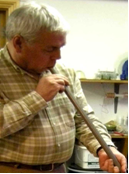The Evidence for the Early Development of British Flint Glass
Colin Brain
Over the last two centuries there has been considerable speculation about how English and Irish flint glass was invented. Through lack of evidence, much of this has been conjectural. However the situation has changed recently. An English Heritage analytical study on excavated glass fragments has provided evidence of how flint glass developed after 1676. The Internet has made it much easier to locate the historical documents that have provided more evidence on the development of the British glass industry up to 1674.
The missing link was the period around 1675, but the continuing assessment of material excavated from the site of Odaccio’s glasshouse in Dublin has provided new evidence about this key period. The paper starts by summarising this archaeological, analytical and historical evidence for the developments that took place in London and Dublin around 1675 and places these in a wider geographic context. The key to these developments was the ready availability of imported high-quality saltpetre through the East India Company. Compared with plant ash this was a very pure alkali, with good oxidising characteristics, but the substitution of materials was not without problems and the Dublin evidence of these and how they were surmounted forms the core of this paper. As with any historical research, one can never answer all the questions: each one answered generates new ones. So the paper concludes by looking at some of these new questions and some possible approaches to answering them
Colin and his wife Sue started researching the history of British drinking glass more than forty years ago. Much of their research has focussed on the second half of the seventeenth century and has included studying: surviving pieces, archaeological finds, historical documents, printed books, and results from glass analysis and practical experiment (the photograph shows Colin trying out a replica 17th century blowing iron). Throughout their research, Colin & Sue have had a great deal of help from others and learnt a lot (particularly how much they still don't know).
Colin is a member of the board of the Association for the History of Glass.

